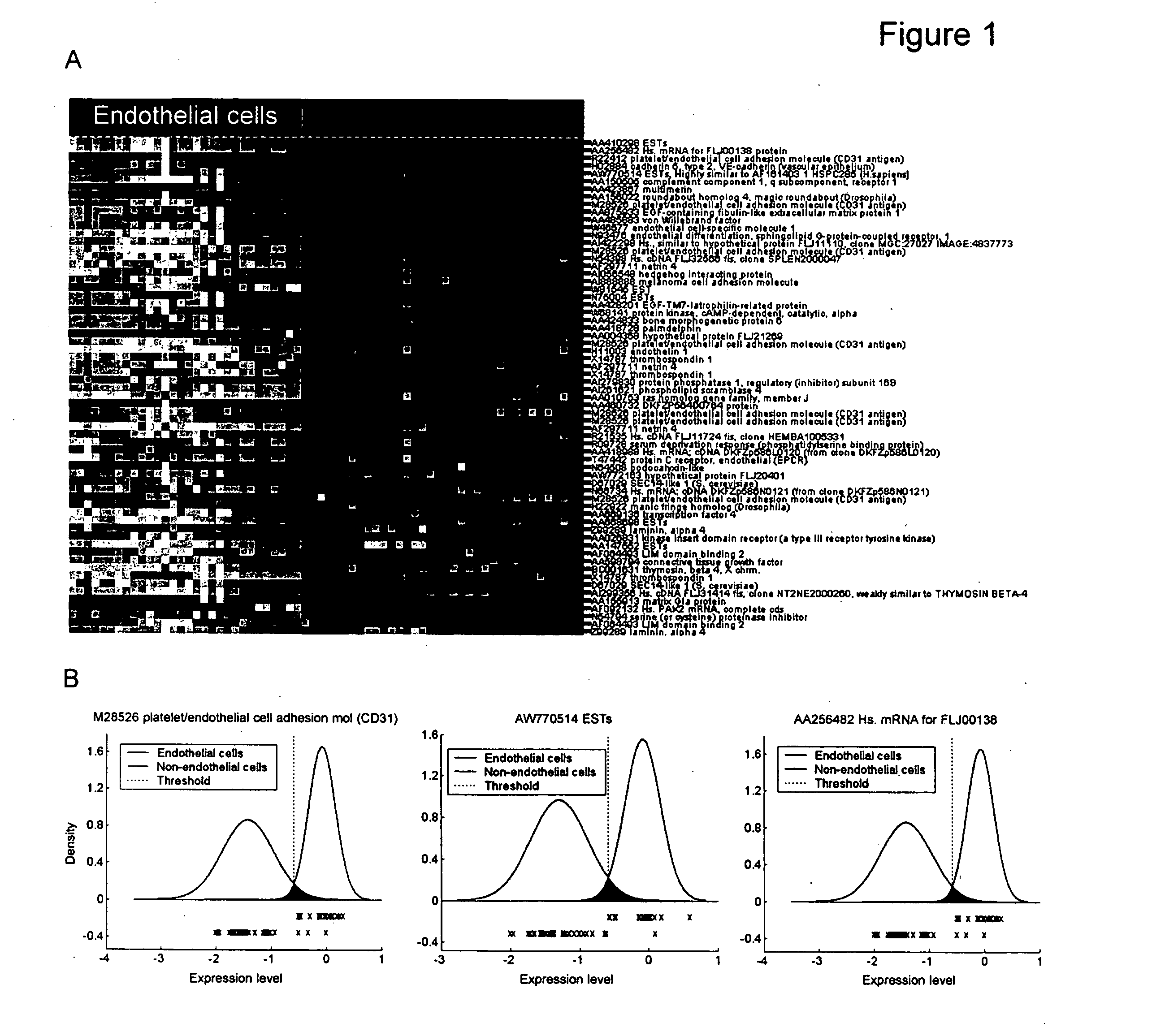Endothelial cell markers and related reagents and methods of use thereof
a technology of endothelial cells and markers, which is applied in the field of endothelial cell markers and related reagents, can solve the problems of poor overall prognosis of breast cancer and achieve the effect of stimulating angiogenesis
- Summary
- Abstract
- Description
- Claims
- Application Information
AI Technical Summary
Benefits of technology
Problems solved by technology
Method used
Image
Examples
example 1
Identification of Candidate Endothelial Cell Specific Genes Using Database Mining
[0268] Overview. Three publicly available gene expression databases were identified and used for this analysis, Unigene at URL www.ncbi.nlm.nih.gov / SAGE / sagexpsetup.cgi, SAGE at URL www.ncbi.nlm.nih.gov / SAGE / SAGEtag.cgi and BodyMap at URL bodymap.ims.u-tokyo.acjp / gene_ranking.php. A metric was employed with each database to identify those SAGE tags that were sequenced in endothelial cell libraries and not in other cell type libraries. Unigene IDs were recorded for each gene identified, or obtained by searching the appropriate database for assignment of a Unigene number. At Unigene, it was possible to employ the Library Differential Display feature, and to identify 29 genes that were differentially expressed in cultured endothelial cells. The SAGE site had information from HMVEC cells in the presence or absence of vascular endothelial cell growth factor, and 256 genes were identified as specifically exp...
example 2
Identification of Candidate Endothelial Cell Specific Genes Using Suppression Subtractive Hybridization
[0273] Materials and Methods
[0274] Cell Culture. Human umbilical vein endothelial cells (HUVEC), human aortic endothelial cells (HAEC), human coronary artery endothelial cells (HCAEC), human lung microvascular endothelial cells (HMVEC), human aortic smooth muscle cells (HASMC), human mammary epithelial cells (HMEC), human aortic smooth muscle cells (HASMC), normal human astrocytes (NHA), and normal human epidermal keratinocytes (NHK) were primary cultured cells obtained from Clonetics, Inc. (San Diego, Calif.). All primary human cells were from single donors ages 33 to 54, except NHA (donor 18 weeks), HASMC and pulmonary HMVEC (donor 3 years), and HUVEC (donated at birth). HCAEC and HAEC were from male donors, other cells were from females, or the gender of the source was not known. Cells were employed for studies at passage 3-9. HepG2 (human hepatocellular carcinoma cell line) c...
example 3
Refinement of Candidate Endothelial Cell Specific Gene Sets
[0278] This example describes the process by which a subset of the candidate genes identified as described in Examples 1 and 2 was selected as being endothelial cell specific, with at least a three-fold difference in expression in endothelial cells relative to a mixed pool of non-endothelial cells.
[0279] Microarray construction and hybridization. For cDNA probe preparation, the 384 virtual subtraction and 288 subtraction hybridization clones were amplified by PCR employing flanking sequences of cloning vectors, according to standard methodology. Five μl of PCR reaction were visualized on 1% agarose gels for quality determination. PCR reactions were purified on a Qiagen BioRobot 3000. In addition, the 288 subtraction hybridization clones were PCR amplified and purified by both Microcon-96 filtrate (Millipore) and Arraylt kits (TeleChem International, Sunnyvale, Calif.). There were not appreciable differences in microarray r...
PUM
| Property | Measurement | Unit |
|---|---|---|
| temperature | aaaaa | aaaaa |
| temperature | aaaaa | aaaaa |
| temperature | aaaaa | aaaaa |
Abstract
Description
Claims
Application Information
 Login to View More
Login to View More - R&D
- Intellectual Property
- Life Sciences
- Materials
- Tech Scout
- Unparalleled Data Quality
- Higher Quality Content
- 60% Fewer Hallucinations
Browse by: Latest US Patents, China's latest patents, Technical Efficacy Thesaurus, Application Domain, Technology Topic, Popular Technical Reports.
© 2025 PatSnap. All rights reserved.Legal|Privacy policy|Modern Slavery Act Transparency Statement|Sitemap|About US| Contact US: help@patsnap.com



